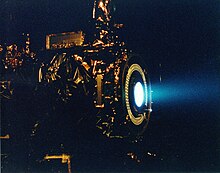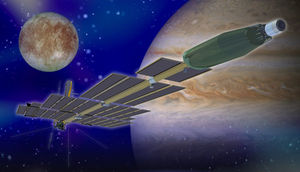Project Prometheus
This article needs additional citations for verification. (February 2010) |

Project Prometheus was established in 2003 by NASA to develop nuclear-powered systems for long-duration space missions. This was NASA's first serious foray into nuclear spacecraft propulsion since the cancellation of the NERVA project in 1972. The project was cancelled in 2005.[1] Its budget shrank from $430 million in 2005 to only $100 million in 2006, $90 million of which was for closeout costs on cancelled contracts.
Namesake
Originally named the "Nuclear Systems Initiative", Project Prometheus was named for the wisest of the Titans in Greek mythology who gave the gift of fire to humanity. NASA said the name Prometheus indicates its hopes of establishing a new tool for understanding nature and expanding capabilities for the exploration of the Solar System.
Motivations
Due to their distance from the Sun, spacecraft exploring the outer planets are severely limited in that they cannot use solar power as a source of electrical energy for onboard instrumentation or for ion propulsion systems. Previous missions to the outer planets such as Voyager and Galileo probe have relied on radioisotope thermoelectric generators (RTG's) as their primary power source. Unlike RTG's which rely on heat produced by the natural decay of radioactive isotopes, Project Prometheus called for the use of a small nuclear reactor as the primary power source.
The primary advantages of this would have been:
- Increased power generation compared to RTG's, allowing scientists and engineers more flexibility in both mission design and operations.
- Increased spacecraft longevity.
- Increased range and propulsion power.
Missions

Missions planned to involve Prometheus Nuclear Systems and Technology included:
- Jupiter Icy Moons Orbiter
- Exploration of the Jovian moons Europa, Ganymede, and Callisto. Originally planned to be the first mission of Project Prometheus, it was deemed too complex and expensive, and its funding was cut in the 2006 budget. NASA instead considered a demonstration mission to a target closer to Earth to test out the reactor and heat rejection systems, possibly with a spacecraft scaled down from its original size.
Technology
Project Prometheus was focused on two types of spacecraft power systems:
- Studies of nuclear thermal rocket engines along similar lines as NERVA.
- Development of rockets powdered by radioisotope thermoelectric generators.
- The use of a nuclear reactor to run ion engines.
Collaboration
Project Prometheus would have had substantial involvement of the U.S. Department of Energy (DOE). Naval Reactors, which oversees the nuclear reactor program of the U.S. Navy, was to participate in the design and construction of the reactors for the Jupiter Icy Moons Orbiter.
See also
- Project Orion (nuclear propulsion)
- NERVA
- Nuclear fission
- Bettis Atomic Power Laboratory
- Magnetoplasmadynamic thruster
Notes
- ^ The National Academy of Sciences (2009). Launching Science: Science Opportunities Provided by NASA's Constellation System. Washington, DC: The National Academies Press. p. 18. ISBN 978-0-309-11644-2. Retrieved 2010-02-14.
External links
- NASA space propulsion and mission analysis office
- BBC audio programme about Project Prometheus
- 982-R120461, PROMETHEUS PROJECT FINAL REPORT Abstract, and link to pdf, of 227 page final report. Retrieved 2010-02-14
